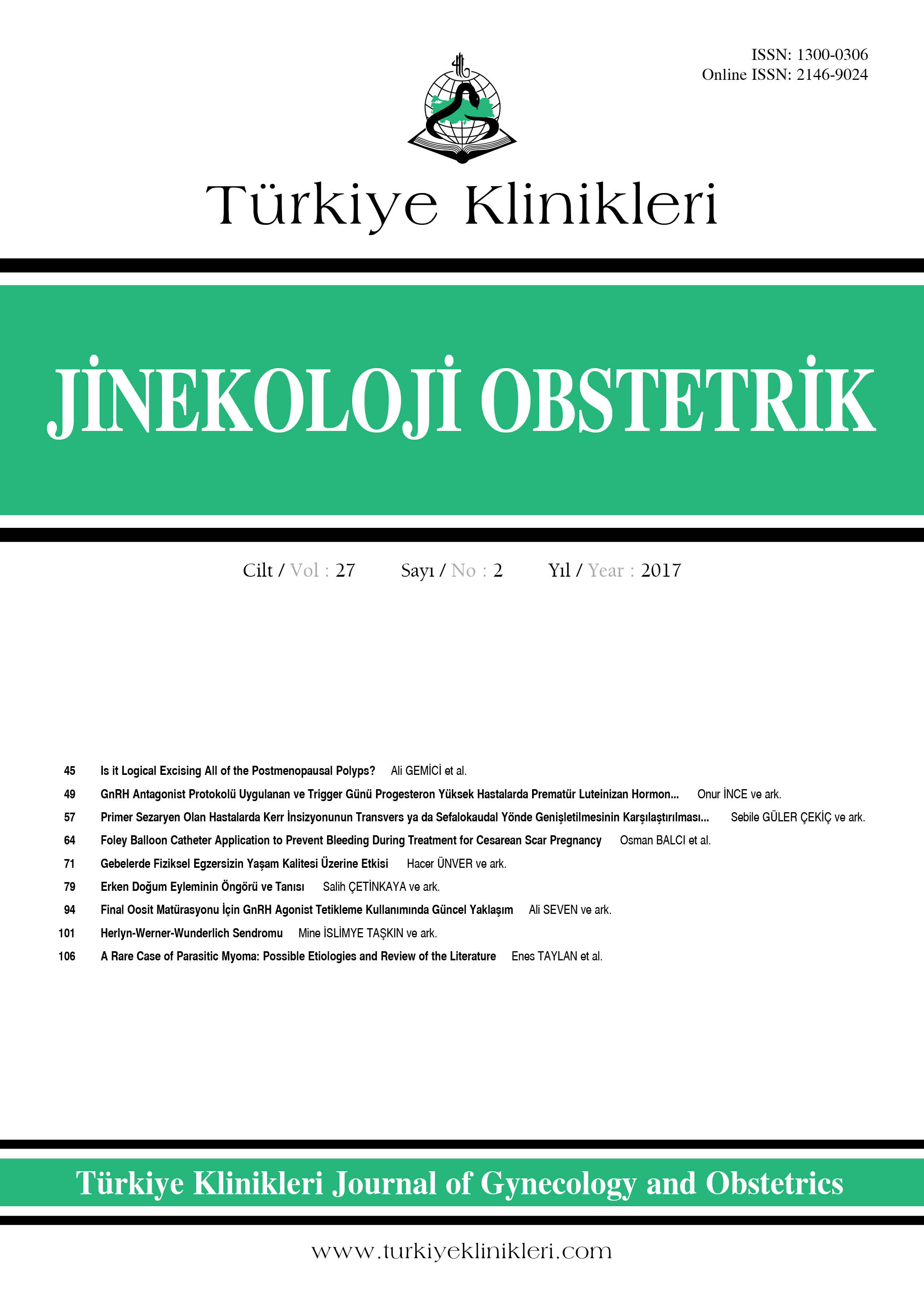Open Access
Peer Reviewed
CASE REPORTS
6286 Viewed2546 Downloaded
Herlyn-Werner-Wunderlich Syndrome: Case Report
Herlyn-Werner-Wunderlich Sendromu
Turkiye Klinikleri J Gynecol Obst. 2017;27(2):101-5
DOI: 10.5336/gynobstet.2015-44958
Article Language: TR
Article Language: TR
Copyright Ⓒ 2025 by Türkiye Klinikleri. This is an open access article under the CC BY-NC-ND license (http://creativecommons.org/licenses/by-nc-nd/4.0/)
ÖZET
Herlyn-Werner-Wunderlich sendromu (HWWS), Müllerian kanal anomalilerinin nadir görülen bir varyantıdır. Klasik triadı: kör hemivajina, uterin didelfis ve ipsilateral renal agenezidir. Klinik prezentasyonu genellikle menarş ile başlayan, progresif olarak artan ve hematokolposa sekonder gelişen şiddetli dismenoredir. Sebebi ve etiyopatogenezi bilinmemekte birlikte, erken tanı ve tedavi komplikasyonların önlenmesi ve fertilitenin korunmasında önemlidir. Bu çalışmada, dış merkezde pelvik kitle saptanması nedeni ile kliniğimize refere edilen, dismenore öyküsü olan, 18 yaşındaki bekâr olguda tanısını manyetik rezonans görüntüleme (MRG) ile koyduğumuz HWWS sunulmuştur. Bu sendrom şiddetli dismenore, pelvik kitle ve renal agenezi ile başvuran genç kadınlarda akla gelmelidir. MRG, HWWS'nun tanısında çok değerli bir görüntüleme yöntemidir. Vajinal septumun rezeksiyonu hem ağrının ortadan kaldırılmasında hem de komplikasyonların önlenmesinde en uygun tedavi yöntemidir.
Herlyn-Werner-Wunderlich sendromu (HWWS), Müllerian kanal anomalilerinin nadir görülen bir varyantıdır. Klasik triadı: kör hemivajina, uterin didelfis ve ipsilateral renal agenezidir. Klinik prezentasyonu genellikle menarş ile başlayan, progresif olarak artan ve hematokolposa sekonder gelişen şiddetli dismenoredir. Sebebi ve etiyopatogenezi bilinmemekte birlikte, erken tanı ve tedavi komplikasyonların önlenmesi ve fertilitenin korunmasında önemlidir. Bu çalışmada, dış merkezde pelvik kitle saptanması nedeni ile kliniğimize refere edilen, dismenore öyküsü olan, 18 yaşındaki bekâr olguda tanısını manyetik rezonans görüntüleme (MRG) ile koyduğumuz HWWS sunulmuştur. Bu sendrom şiddetli dismenore, pelvik kitle ve renal agenezi ile başvuran genç kadınlarda akla gelmelidir. MRG, HWWS'nun tanısında çok değerli bir görüntüleme yöntemidir. Vajinal septumun rezeksiyonu hem ağrının ortadan kaldırılmasında hem de komplikasyonların önlenmesinde en uygun tedavi yöntemidir.
ANAHTAR KELİMELER: Hematokolpos; manyetik rezonans görüntüleme; kalıtsal renal agenezis; endometriyoz
ABSTRACT
Herlyn-Werner-Wunderlich syndrome (HWWS) is a rare variant of Müllerian duct anomalies. The classic triad of this syndrome: obstructed hemivagina, didelphys uterus and ipsilateral renal agenesis. It typically presents with severe and progressive dysmenorrhea starting after menarche that was determined secondary to hematocolpos. Although the exact cause and pathogenesis of the syndrome are uncertain; the diagnosis and treatment at an early stage can prevent complications and preserve fertility. Herein we describe the case of 18-year-old who presented with dysmenorrhea and pelvic mass and that we confirmed the diagnosis with magnetic resonance imaging (MRI). When unilateral renal agenesis, severe dysmenorrhea and pelvic mass coexist in a young girl, physicians should remember HWWS. MRI is a very suitable diagnostic tool in order to perform the correct diagnosis. Vaginal septum resection is the best treatment method for reducing pain and preventing the complications.
Herlyn-Werner-Wunderlich syndrome (HWWS) is a rare variant of Müllerian duct anomalies. The classic triad of this syndrome: obstructed hemivagina, didelphys uterus and ipsilateral renal agenesis. It typically presents with severe and progressive dysmenorrhea starting after menarche that was determined secondary to hematocolpos. Although the exact cause and pathogenesis of the syndrome are uncertain; the diagnosis and treatment at an early stage can prevent complications and preserve fertility. Herein we describe the case of 18-year-old who presented with dysmenorrhea and pelvic mass and that we confirmed the diagnosis with magnetic resonance imaging (MRI). When unilateral renal agenesis, severe dysmenorrhea and pelvic mass coexist in a young girl, physicians should remember HWWS. MRI is a very suitable diagnostic tool in order to perform the correct diagnosis. Vaginal septum resection is the best treatment method for reducing pain and preventing the complications.
MENU
POPULAR ARTICLES
MOST DOWNLOADED ARTICLES





This journal is licensed under a Creative Commons Attribution-NonCommercial-NoDerivatives 4.0 International License.










